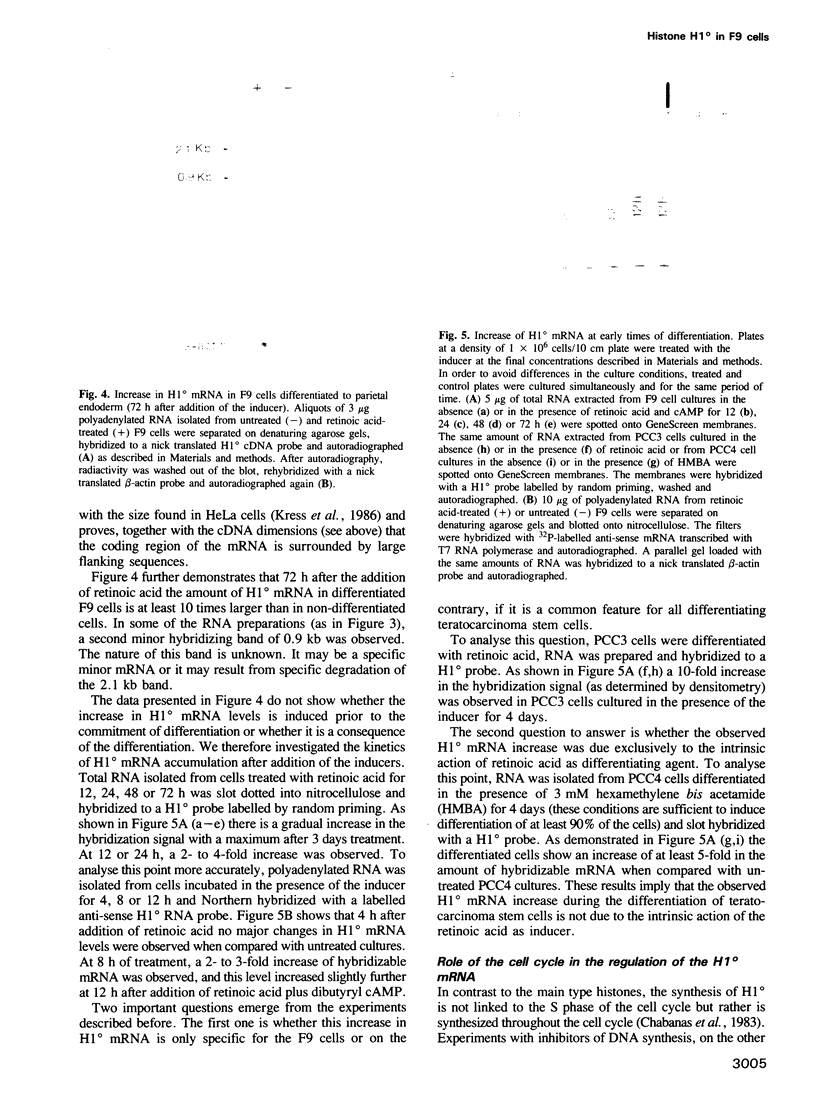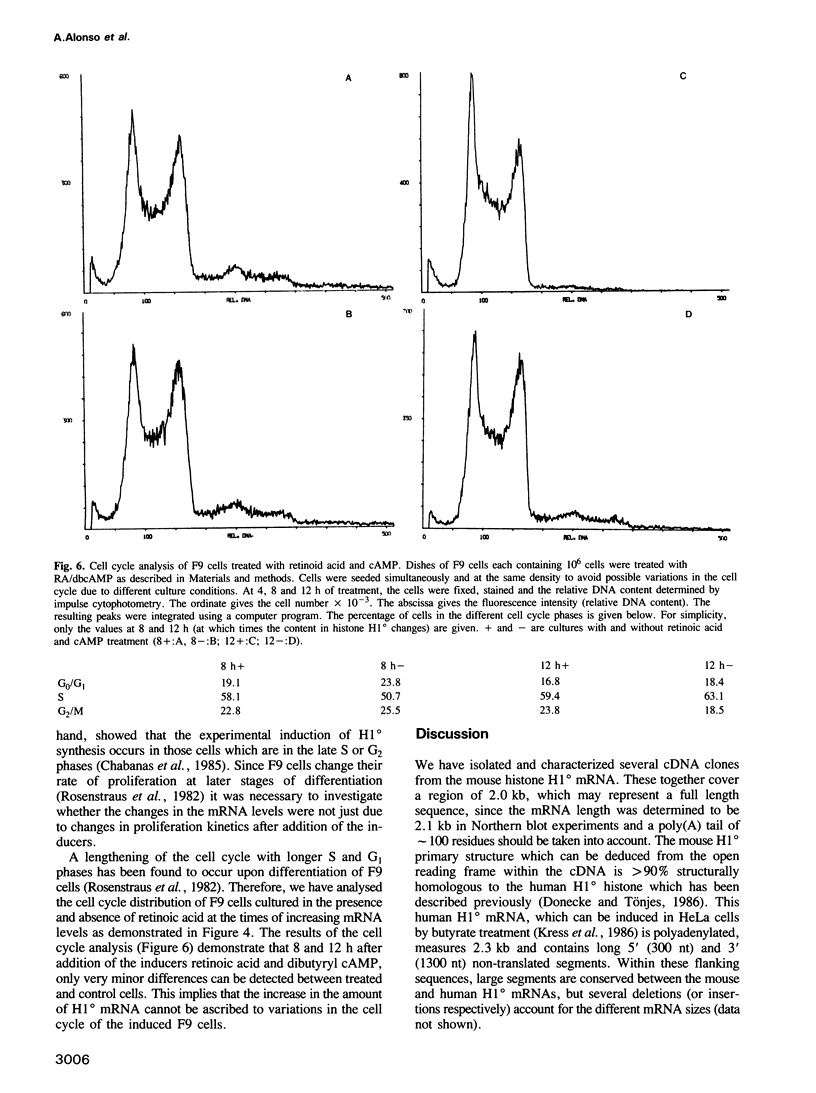Abstract
We have isolated and characterized cDNA clones coding for the H1 histone subtype H1(0) in mouse teratocarcinoma cells. The mRNA is 2100 nt long and contains a coding sequence which is highly related to that of the human H1(0) gene. Using this cDNA as a probe, we have shown that, in comparison to undifferentiated F9 cells, differentiated F9 teratocarcinoma cells contain large amounts of H1(0) mRNA. This increase takes place very early during differentiation and does not correlate with changes in the rate of cell division. This indicates that the accumulation of H1(0) mRNA is not the result of reduced proliferation. Most likely on the contrary, the increase in the amount of H1(0) and the resulting effects on the formation of high order chromatin structures are parts of the differentiation program induced in F9 cells.
Full text
PDF





Images in this article
Selected References
These references are in PubMed. This may not be the complete list of references from this article.
- Chabanas A., Khoury E., Goeltz P., Froussard P., Gjerset R., Dod B., Eisen H., Lawrence J. J. Effects of butyric acid on cell cycle regulation and induction of histone H1(0) in mouse cells and tissue culture. Inducibility of H1 (0)in the late S-G2 phase of the cell cycle. J Mol Biol. 1985 May 25;183(2):141–151. doi: 10.1016/0022-2836(85)90208-6. [DOI] [PubMed] [Google Scholar]
- Chabanas A., Lawrence J. J., Humbert J., Eisen H. Cell cycle regulation of histone H1O in CHO cells: a flow cytofluorimetric study after double staining of the cells. EMBO J. 1983;2(6):833–837. doi: 10.1002/j.1460-2075.1983.tb01510.x. [DOI] [PMC free article] [PubMed] [Google Scholar]
- D'Anna J. A., Gurley L. R., Becker R. R. Histones H1(o)a and H1(o)b are the same as CHO histones H1(III) and H1(IV): new features of H1(o) phosphorylation during the cell cycle. Biochemistry. 1981 Jul 21;20(15):4501–4505. doi: 10.1021/bi00518a041. [DOI] [PubMed] [Google Scholar]
- Doenecke D., Tönjes R. Conserved dyad symmetry structures at the 3' end of H5 histone genes. Analysis of the duck H5 gene. J Mol Biol. 1984 Sep 15;178(2):121–135. doi: 10.1016/0022-2836(84)90135-9. [DOI] [PubMed] [Google Scholar]
- Doenecke D., Tönjes R. Differential distribution of lysine and arginine residues in the closely related histones H1 and H5. Analysis of a human H1 gene. J Mol Biol. 1986 Feb 5;187(3):461–464. doi: 10.1016/0022-2836(86)90446-8. [DOI] [PubMed] [Google Scholar]
- Fried J., Perez A. G., Clarkson B. D. Flow cytofluorometric analysis of cell cycle distributions using propidium iodide. Properties of the method and mathematical analysis of the data. J Cell Biol. 1976 Oct;71(1):172–181. doi: 10.1083/jcb.71.1.172. [DOI] [PMC free article] [PubMed] [Google Scholar]
- Gjerset R., Gorka C., Hasthorpe S., Lawrence J. J., Eisen H. Developmental and hormonal regulation of protein H1 degrees in rodents. Proc Natl Acad Sci U S A. 1982 Apr;79(7):2333–2337. doi: 10.1073/pnas.79.7.2333. [DOI] [PMC free article] [PubMed] [Google Scholar]
- Keppel F., Allet B., Eisen H. Appearance of a chromatin protein during the erythroid differentiation of Friend virus-transformed cells. Proc Natl Acad Sci U S A. 1977 Feb;74(2):653–656. doi: 10.1073/pnas.74.2.653. [DOI] [PMC free article] [PubMed] [Google Scholar]
- Kress H., Tönjes R., Doenecke D. Butyrate induced accumulation of a 2.3 kb polyadenylated H1(0) histone mRNA in HeLa cells. Nucleic Acids Res. 1986 Sep 25;14(18):7189–7197. doi: 10.1093/nar/14.18.7189. [DOI] [PMC free article] [PubMed] [Google Scholar]
- Krieg P. A., Robins A. J., D'Andrea R., Wells J. R. The chicken H5 gene is unlinked to core and H1 histone genes. Nucleic Acids Res. 1983 Feb 11;11(3):619–627. doi: 10.1093/nar/11.3.619. [DOI] [PMC free article] [PubMed] [Google Scholar]
- Levine R. A., Campisi J., Wang S. Y., Gudas L. J. Butyrate inhibits the retinoic acid-induced differentiation of F9 teratocarcinoma stem cells. Dev Biol. 1984 Oct;105(2):443–450. doi: 10.1016/0012-1606(84)90301-4. [DOI] [PubMed] [Google Scholar]
- Maxam A. M., Gilbert W. A new method for sequencing DNA. Proc Natl Acad Sci U S A. 1977 Feb;74(2):560–564. doi: 10.1073/pnas.74.2.560. [DOI] [PMC free article] [PubMed] [Google Scholar]
- McCue P. A., Matthaei K. I., Taketo M., Sherman M. I. Differentiation-defective mutants of mouse embryonal carcinoma cells: response to hexamethylenebisacetamide and retinoic acid. Dev Biol. 1983 Apr;96(2):416–426. doi: 10.1016/0012-1606(83)90179-3. [DOI] [PubMed] [Google Scholar]
- Melton D. A., Krieg P. A., Rebagliati M. R., Maniatis T., Zinn K., Green M. R. Efficient in vitro synthesis of biologically active RNA and RNA hybridization probes from plasmids containing a bacteriophage SP6 promoter. Nucleic Acids Res. 1984 Sep 25;12(18):7035–7056. doi: 10.1093/nar/12.18.7035. [DOI] [PMC free article] [PubMed] [Google Scholar]
- Osborne H. B., Chabanas A. Kinetics of histone H10 accumulation and commitment to differentiation in murine erythroleukemia cells. Exp Cell Res. 1984 Jun;152(2):449–458. doi: 10.1016/0014-4827(84)90646-3. [DOI] [PubMed] [Google Scholar]
- Panyim S., Chalkley R. A new histone found only in mammalian tissues with little cell division. Biochem Biophys Res Commun. 1969 Dec 4;37(6):1042–1049. doi: 10.1016/0006-291x(69)90237-x. [DOI] [PubMed] [Google Scholar]
- Renz M., Nehls P., Hozier J. Involvement of histone H1 in the organization of the chromosome fiber. Proc Natl Acad Sci U S A. 1977 May;74(5):1879–1883. doi: 10.1073/pnas.74.5.1879. [DOI] [PMC free article] [PubMed] [Google Scholar]
- Roche J., Gorka C., Goeltz P., Lawrence J. J. Association of histone H1(0) with a gene repressed during liver development. Nature. 1985 Mar 14;314(6007):197–198. doi: 10.1038/314197a0. [DOI] [PubMed] [Google Scholar]
- Rosenstraus M. J., Sundell C. L., Liskay R. M. Cell-cycle characteristics of undifferentiated and differentiating embryonal carcinoma cells. Dev Biol. 1982 Feb;89(2):516–520. doi: 10.1016/0012-1606(82)90340-2. [DOI] [PubMed] [Google Scholar]
- Ruiz-Carrillo A., Affolter M., Renaud J. Genomic organization of the genes coding for the six main histones of the chicken: complete sequence of the H5 gene. J Mol Biol. 1983 Nov 15;170(4):843–859. doi: 10.1016/s0022-2836(83)80191-0. [DOI] [PubMed] [Google Scholar]
- Smith B. J., Harris M. R., Sigournay C. M., Mayes E. L., Bustin M. A survey of H1o-and H5-like protein structure and distribution in higher and lower eukaryotes. Eur J Biochem. 1984 Jan 16;138(2):309–317. doi: 10.1111/j.1432-1033.1984.tb07916.x. [DOI] [PubMed] [Google Scholar]
- Smith B. J., Johns E. W. Isolation and characterisation of subfractions of nuclear protein H1 degree. FEBS Lett. 1980 Jan 28;110(1):25–29. doi: 10.1016/0014-5793(80)80014-7. [DOI] [PubMed] [Google Scholar]
- Strickland S., Mahdavi V. The induction of differentiation in teratocarcinoma stem cells by retinoic acid. Cell. 1978 Oct;15(2):393–403. doi: 10.1016/0092-8674(78)90008-9. [DOI] [PubMed] [Google Scholar]
- Strickland S., Smith K. K., Marotti K. R. Hormonal induction of differentiation in teratocarcinoma stem cells: generation of parietal endoderm by retinoic acid and dibutyryl cAMP. Cell. 1980 Sep;21(2):347–355. doi: 10.1016/0092-8674(80)90471-7. [DOI] [PubMed] [Google Scholar]
- Thoma F., Koller T., Klug A. Involvement of histone H1 in the organization of the nucleosome and of the salt-dependent superstructures of chromatin. J Cell Biol. 1979 Nov;83(2 Pt 1):403–427. doi: 10.1083/jcb.83.2.403. [DOI] [PMC free article] [PubMed] [Google Scholar]
- Tönjes R., Doenecke D. A highly conserved sequence in H1 histone genes as an oligonucleotide hybridization probe: isolation and sequence of a duck H1 gene. J Mol Evol. 1987;25(4):361–370. doi: 10.1007/BF02603121. [DOI] [PubMed] [Google Scholar]
- Wang S. Y., LaRosa G. J., Gudas L. J. Molecular cloning of gene sequences transcriptionally regulated by retinoic acid and dibutyryl cyclic AMP in cultured mouse teratocarcinoma cells. Dev Biol. 1985 Jan;107(1):75–86. doi: 10.1016/0012-1606(85)90377-x. [DOI] [PubMed] [Google Scholar]
- Weintraub H. Histone-H1-dependent chromatin superstructures and the suppression of gene activity. Cell. 1984 Aug;38(1):17–27. doi: 10.1016/0092-8674(84)90522-1. [DOI] [PubMed] [Google Scholar]
- Yasuda H., Logan K. A., Bradbury E. M. Antibody against globular domain of H10 histone. FEBS Lett. 1984 Jan 30;166(2):263–266. doi: 10.1016/0014-5793(84)80092-7. [DOI] [PubMed] [Google Scholar]





